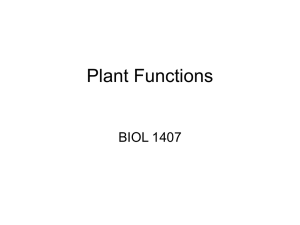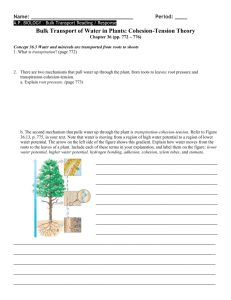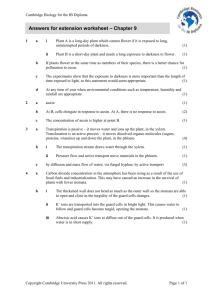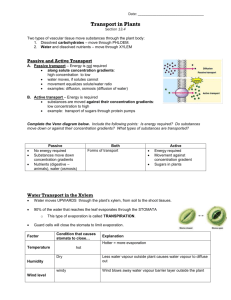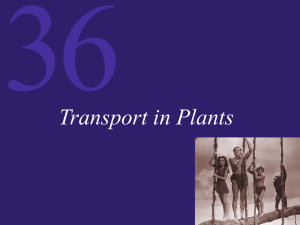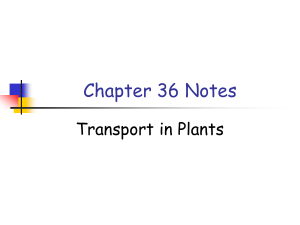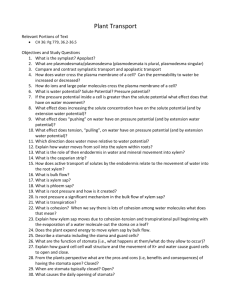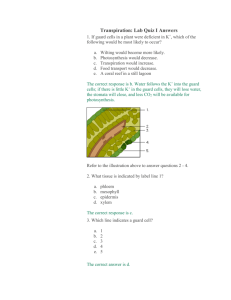Transport in Angiosperms 9.2
advertisement
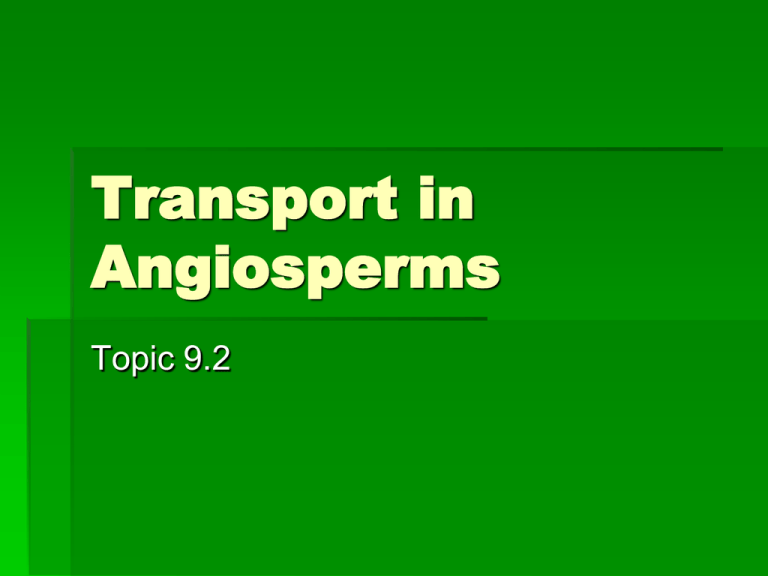
Transport in Angiosperms Topic 9.2 Transpiration 9.2.5-9.2.10 The loss of water vapor from leaves occurs through stomata. Stomata are surrounded by 2 guard cells which open and close As water exits the leaves, it is replaced by water entering via the root Energy from the sun drives this process: transpiration-adhesion-cohesion-tension theory. The process of transpiration Heat is produced when light strikes a leaf. Water in the spongy mesophyll tissue enters the vapour phase. Water evaporates through the stomatal pore down a humidity gradient. The evaporation of water draws (pulls) more water by mass flow into the spongy mesophyll space. Water molecules are held together cohesion due to hydrogen bonds between water molecules. In turn this draws water from the end of the xylem by the same cohesion. Water is therefore drawn up the stem by cohesion between water molecules and adhesion to the xylem vessel walls. This transpiration 'pull or tension' extends all the way down the xylem to the root The xylem 2 major cell types Tracheids – dead at maturity. Have tapered ends that connect to other tracheids via pits Vessel elements – dead at maturity with lignified (woody) cell walls. These lie end to end like straws. These are most efficient at moving water. Ancient plants had only tracheids Most modern plants have only vessel elements The CO2 dilemma! Plants can only acquire carbon dioxide when their stomata are open. Remember CO2 is necessary for carbon fixation in photosynthesis. Guard cells regulate the opening and closing of the stomata Guard cells The walls of the cells are of uneven thickness (inner wall thicker than outer) When the cells take in water the outer part bulges which opens the stomata. When they lose water they sag and collapse over the stomatal opening. Potassium ions are actively pumped into the guard cells causing water to enter via osmosis, thus opening the stomata. K ion pumps are stimulated by light from the blue part of the spectrum. As the ions diffuse out so does water, collapsing the guard cells. The hormone abscisic acid causes K ions to diffuse from the guard cells rapidly. This hormone is made by the roots in times of drought To study Table page 250 – how environmental factors affect transpiration Table page 253 – details of the transpiration-cohesion-tension theory Xerophytes adaptations Plants adapted to dry (arid) climates Small thick leaves Stomata in pits Waxy cuticle Fewer stomata Hairs on leaves Loss of leaves in dry months Water storage in stems Alternate photosynthetic processes Both processes developed to conserve water CAM – crassulacean acid metabolism. Carbon dioxide is fixed at night and incorporated into organic acids. It is released during the day for photosynthesis C4 photosynthesis – Carbon dioxide is incorporated into a 4-C compound then moved to the interior of the leaf. More Carbon dioxide can be fixed than in a C3 plant Roots 9.2.1 – 9.2.3 Recall that root epidermal cells have extensions called root hairs to increase the surface area for water and mineral absorption. As a root pushes through the soil it is protected by a root cap. •Zone of cell division – closest to tip, cells undifferentiated, mitosis is occurring •Zone of elongation – cells are enlarging, G1 of cell cycle •Zone of maturation – cells are differentiating and beginning to function. This is where root hairs begin to be noticed. Water movement Water must travel through the root to the vascular cylinder which is in the center of the root. The vascular cylinder is surrounded by endodermis and pericycle Pericycle consists of cells that can produce lateral roots Endodermis is a cylinder 1 cell thick that forms a selective barrier which regulates passage of substances from soil into VC Each endodermal cell has a barrier called the Casperian strip. This strip is made of suberin, a waxy, impermeable layer The impermeable suberin ensures that all water and minerals entering the plant must cross a semipermeable membrane. Passage of water and minerals into root Root hairs absorb soil solution (water and minerals) The soil solution can travel 2 routes Apoplastic route Symplastic route Apoplastic route Water and minerals travel between cell walls through the cortex region Some solution enters cells some does not When the solution reaches the endodermis, the Casperian strip forces the solution into a cell so that it has to pass through a cell membrane Symplastic route Soil solution passes through cells (and their membranes) on their way to the stele (vascular cylinder) Once past the endodermis, water and minerals enter the xylem vessels to be transported throughout the plant. Is the solution (now called xylem sap) pushed or pulled through a plant? Push due to root pressure Pull by tension generated by transpiration Movement of ions through plants Minerals dissolved in water may enter by diffusion if concentration inside the root is lower than concentration outside root Fungal hyphae called mycorrhiza increase the root surface area for water and mineral absorption (mutualism) If mineral concentration inside the plant is higher than in the soil, active transport is required. This is also necessary if the ion cannot cross the phospholipid bilayer. Active transport requires a transport protein K + ions move through proteins called potassium channels Proton pump ATP provides energy to pump H+ ions out of cell This makes the inside of the cell more negative than the outside The hydrogen ion gradient causes a voltage difference called membrane potential. (-120 mv) Membrane potential is a form of potential energy that can be used to absorb mineral ions. Hydrogen ions may displace cations attached to the soil, freeing them so they may enter root Hydrogen ions may combine with anions and drag the anion into the root via cotransport 9.2.4 Plant support Cellulose cell walls – walls may thicken for additional support Lignified cell - A complex polymer, the chief noncarbohydrate constituent of wood, that binds to cellulose fibers and hardens and strengthens the cell. Collenchyma, vascular bundles, sclerenchyma, provide flexible support Turgor pressure How do osmosis, the plant cell vacuole, and the plant cell wall work together to provide turgor pressure? What happens if turgor pressure is lost? 9.2.11 Movement of Sugars AKA Translocation Sugars and organic molecules are transported through sieve tube members and their companion cells Place where molecules originate is called the source. Could be a leaf or a storage organ Place where molecules are going is called the sink. Could be where growth is occurring or a fruit or tuber Companion cells load sucrose (soluble and not metabolically active) into sieve tubes. Water follows via osmosis causing positive pressure in sieve tube. This makes phloem sap flow. Companion cells unload sucrose at sink (requires ATP as it is against concentration gradient. Sugars may be converted to starch in sink Water used in translocation is recycled by xylem 1. Source produces organic molecules 2. Glucose from photosynthesis produced 3.Glucose converted to sucrose for transport 4. Companion cell actively loads the sucrose 5. Water follows from xylem by osmosis 6. Sap volume and pressure increased to give Mass flow 7. Unload the organic molecules by the companion cell 8. Sucrose stored as the insoluble and unreactive starch 9. Water that is released is picked up by the xylem 10. water recycles as part of transpiration to re supply the sucrose loading Source: http://www.click4biology.info/c4b/9/plant9.2.htm#11
